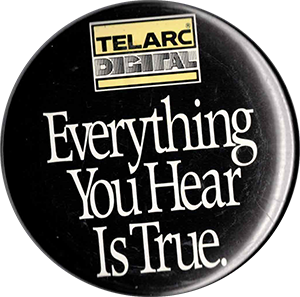Sidebar: What is Digital Audio?
This project focuses on digital audio and Telarc’s use of it. In order to understand the impact of Telarc’s work, especially in the early days of the digital audio era, it may help to understand what digital audio is, and how it differs from analog audio. An excellent explanation comes from someone integral to the Telarc story, Soundstream founder Thomas Stockham:
There are two numbers that determine the potential sound quality of a typical digital recording: bit depth and sample rate. Entire books have been written on this subject, but to help understand the technology discussed in this project a quick explanation is in order. As Dr. Stockham recounted above, digital audio is a series of values representing the audio signal. The larger the number (“bit depth”), the larger the dynamic range of the signal. And the more often the sound is measured (“sample rate”), the higher the frequency the system can accurately capture. At the time of this writing, a 96 kHz sample rate and a 24-bit bit depth is a common standard for audio engineers.
In 1985, a technical paper was published that rethought this method of digitizing sound.2 Direct Stream Digital (DSD), the format that grew from this research, was presented by engineers from Sony at a conference in March of 1996. DSD handled audio in a completely different (and incompatible) way, and this required all new equipment and editing software.3 Telarc leapt right in and recorded nearly all of their subsequent sessions with DSD (and touted the fact on the disc covers). They also engaged engineer Paul Blakemore to transfer the Soundstream tapes from their earliest recordings to the DSD format in order to capture some of the sonic quality that was lost in the original transfer to LP and CD.4
Digital audio, when properly done, has the potential to record and playback sound with greater accuracy and lower noise and distortion than analog audio. However, there are those who will passionately argue for the sonic qualities of analog. The debate among adherents to the various approaches has filled many articles and discussion pages.5
Much has been said about the upward potential of digital, but there is also a raising of the floor. For anyone who has ever worn out an LP or broken a tape, the advent of CD – and later of digital file playback – may have come as a relief. Even the cheapest of CD players does not suffer from ticks and pops because error correction within the player’s algorithm can work around minor blemishes to generate an error-free playback. (Of course, large scratches and smudges will cause dropouts in the sound. Be sure to clean your CDs in the proper manner!) As for wear and tear, the laser in a player makes no contact with the disc and so does not wear it down, and a digital file can be played back virtually anywhere without suffering from its environment. So in these ways, does digital raise the floor as much as it breaks through the ceiling of analog audio?
Last updated on April 16th, 2024 at 03:25 pm
- Thomas Stockham, “Records of the Future,” The Phonograph and Sound Recording After One-Hundred Years: Centennial Issue (New York: Audio Engineering Society, 1977). ↩︎
- Ayatake Nishio et al., “Direct Stream Digital Audio System,” (Audio Engineering Society 100th Convention, Copenhagen, Denmark, 1996), ↩︎
- This article wades into the differences between DSD and PCM, one of many on the subject. In short, PCM is the earliest and most common form of digital audio, used in CDs, DVDs, and most streaming audio. Googling “DSD vs PCM” yields over 6,000 hits and as always, one must take care to separate science from speculation. ↩︎
- “Telarc’s Classic Soundstream Recordings Re-Mastered,” AudioXpress, December 2002, p. 58 ↩︎
- Pour yourself a big cup of coffee, type “digital vs analog audio” into any search engine. and sit back. See also Greg Milner’s book, Perfecting Sound Forever (Faber and Faber, 2010). ↩︎
